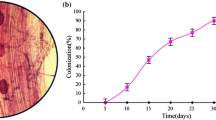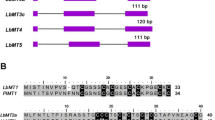Abstract
Fungus-growing termites have a symbiotic relationship with the basidiomycetes of the genus Termitomyces. This symbiotic system is able to degrade dead plant material efficiently. We conducted expressed sequence tag (EST) analysis of a symbiotic Termitomyces fungus degrading plant material in a field nest of the termite Macrotermes gilvus. A subtractive cDNA library was also investigated to facilitate the discovery of genes expressed specifically under the symbiotic conditions. A total of 2,613 ESTs were collected and resulted in 1,582 nonredundant tentative consensus sequences, of which approximately 59% showed significant similarity to known protein sequences. A number of homologous sequences to genes involved in plant cell wall degradation were identified and a majority of them encoded putative pectinolytic enzymes. Real-time quantitative reverse transcriptase polymerase chain reaction analyses confirmed significant upregulation of putative stress response genes under symbiotic conditions. The present ESTs database provides a valuable resource for molecular biological study of plant material degradation in the symbiosis between termites and fungi.

Similar content being viewed by others
References
Abe T, Matsumoto T (1979) Studies on the distribution and ecological role of termites in a lowland rain forest of west Malaysia. 3. Distribution and abundance of termites in Pasoh Forest Reserve. Japanese Journal of Ecology 29:337–351
Altschul SF, Madden TL, Schaffer AA, Zhang J, Zhang Z, Miller W Lipman DJ (1997) Gapped BLAST and PSI-BLAST: a new generation of protein database search programs. Nucleic Acids Res 25:3389–3402
Bateman A, Coin L, Durbin R, Finn RD, Hollich V, Griffiths-Jones S, Khanna A, Marshall M, Moxon S, Sonnhammer EL, Studholme DJ, Yeats C, Eddy SR (2004) The Pfam protein families database. Nucleic Acids Res 32:D138–D141
Bendtsen JD, Nielsen H, von Heijne G, Brunak S (2004) Improved prediction of signal peptides: SignalP 3.0. J Mol Biol 340:783–795
Coutinho PM, Henrissat B (1999) Carbohydrate-active enzymes: an integrated database approach. In: Gilbert HJ, Davis B, Henrissat B, Svensson B (eds) Recent advances in carbohydrate bioengineering. The Royal Society of Chemistry, Cambridge, pp 3–12
Garcia-Garrido JM, Ocampo JA (2002) Regulation of the plant defence response in arbuscular mycorrhizal symbiosis. J Exp Bot 53:1377–1386
Grassé P-P, Noirot C (1958) Le meule des termites chqmpignonnistes et sa signification symbiotique. Ann Sci Nat Zool Biol Anim 20:113–128
Hyodo F, Inoue T, Azuma J-I, Tayasu I, Abe T (2000) Role of the mutualistic fungus in lignin degradation in the fungus-growing termite Macrotermes gilvus (Isoptera; Macrotermitinae). Soil Biol Biochem 32:653–658
Johjima T, Inoue T, Ohkuma M, Noparatnaraporn N, Kudo T (2003) Chemical analysis of food processing by the fungus-growing termite Macrotermes gilvus. Sociobiology 42:815–824
Kalshoven LGE (1956) Observation on Macrotermes gilvus Holmgr. in Java-3. Accumulations of finely cut vegetable matter in the nests. Insectes Soc 3:455–461
Loftus BJ, Fung E, Roncaglia P, Rowley D, Amedeo P, Bruno D, Vamathevan J, Miranda M, Anderson IJ, Fraser JA, Allen JE, Bosdet IE, Brent MR, Chiu R, Doering TL, Donlin MJ, D’Souza CA, Fox DS, Grinberg V, Fu J, Fukushima M, Haas BJ, Huang JC, Janbon G, Jones SJ, Koo HL, Krzywinski MI, Kwon-Chung JK, Lengeler KB, Maiti R, Marra MA, Marra RE, Mathewson CA, Mitchell TG, Pertea M, Riggs FR, Salzberg SL, Schein JE, Shvartsbeyn A, Shin H, Shumway M, Specht CA, Suh BB, Tenney A, Utterback TR, Wickes BL, Wortman JR, Wye NH, Kronstad JW, Lodge JK, Heitman J, Davis RW, Fraser CM, Hyman RW (2005) The genome of the basidiomycetous yeast and human pathogen Cryptococcus neoformans. Science 307:1321–1324
Martin MM, Martin JS (1978) Cellulose digestion in the midgut of the fungus-growing termites Macrotermes natalensis: the role of acquired digestive enzymes. Science 199:1453–1455
Martinez D, Larrondo LF, Putnam N, Gelpke MD, Huang K, Chapman J, Helfenbein KG, Ramaiya P, Detter JC, Larimer F, Coutinho PM, Henrissat B, Berka R, Cullen D, Rokhsar D (2004) Genome sequence of the lignocellulose degrading fungus Phanerochaete chrysosporium strain RP78. Nat Biotechnol 22:695–700
Matoub M, Rouland C (1995) Purification and properties of the xylanases from the termites Macrotermes bellicosus and its symbiotic fungus Termitomyces sp. Comp Biochem Physiol 112:629–635
Meissner PS, Sisk WP, Berman ML (1987) Bacteriophage lambda cloning system for the construction of directional cDNA libraries. Proc Natl Acad Sci U S A 84:4171–4175
Melin P, Schnurer J, Wagner EG (2002) Proteome analysis of Aspergillus nidulans reveals proteins associated with the response to the antibiotic concanamycin A, produced by Streptomyces species. Mol Genet Genomics 267:695–702
Moriya S, Inoue T, Ohkuma M, Taprab Y, Johjima T, Suwanarit P, Sangwanit U, Vongkaluang C, Noparatnaraporn N, Kudo T (2005) Fungal community analysis of fungus gardens in Termite nests. Microbes Environ 20:243–252
Ragauskas AJ, Williams CK, Davison BH, Britovsek G, Cairney J, Eckert CA, Frederick WJ Jr, Hallett JP, Leak DJ, Liotta CL, Mielenz JR, Murphy R, Templer R, Tschaplinski T (2006) The path forward for biofuels and biomaterials. Science 311:484–489
Rouland-Lefève C, Johjima T, Inoue T (2006) Termitomyces/termite interactions. In: König H, Varma A (eds) Intestinal microorganisms of termites and other invertebrates. Springer, Berlin Heidelberg New York, pp 335–350
Rouland-Lefèvre C, Bignell DE (2001) Cultivation of symbiotic fungi by termites of the subfamily Macrotermitinae. In: Seckbach J (ed) Symbiosis. Kluwer, Netherlands, pp 731–756
Shibata Y, Carninci P, Watahiki A, Shiraki T, Konno H, Muramatsu M Hayashizaki Y (2001) Cloning full-length, cap-trapper-selected cDNAs by using the single-strand linker ligation method. Biotechniques 30:1250–1254
Skinner W, Keon J, Hargreaves J (2001) Gene information for fungal plant pathogens from expressed sequences. Curr Opin Microbiol 4:381–386
Stajich JE, Block D, Boulez K, Brenner SE, Chervitz SA, Dagdigian C, Fuellen G, Gilbert JG, Korf I, Lapp H, Lehvaslaiho H, Matsalla C, Mungall CJ, Osborne BI, Pocock MR, Schattner P, Senger M, Stein LD, Stupka E, Wilkinson MD Birney E (2002) The Bioperl toolkit: Perl modules for the life sciences. Genome Res 12:1611–1618
Taprab Y, Ohkuma M, Johjima T, Maeda Y, Moriya S, Inoue T, Suwanarit P, Noparatnaraporn N, Kudo T (2002) Molecular phylogeny of symbiotic basidiomycetes of fungus-growing termites in Thailand and their relationship with the host. Biosci Biotechnol Biochem 66:1159–1163
Taprab Y, Johjima T, Maeda Y, Moriya S, Trakulnaleamsai S, Noparatnaraporn N, Ohkuma M, Kudo T (2005) Symbiotic fungi produce laccases potentially involved in phenol degradation in fungus combs of fungus-growing termites in Thailand. Appl Environ Microbiol 71:7696–7704
Tasaki Y, Azwan A, Hara T, Joh T (2004) Structure and expression of a phosphate deficiency-inducible ribonuclease gene in Pholiota nameko. Curr Genet 45:28–36
Treger JM, McEntee K (1990) Structure of the DNA damage-inducible gene DDR48 and evidence for its role in mutagenesis in Saccharomyces cerevisiae. Mol Cell Biol 10:3174–3184
Wasmuth JD, Blaxter ML (2004) prot4EST: translating expressed sequence tags from neglected genomes. BMC Bioinformatics 5:187
Willats WG, McCartney L, Mackie W, Knox JP (2001) Pectin: cell biology and prospects for functional analysis. Plant Mol Biol 47:9–27
Wood TG, Sands WA (1978) The role of termites in ecosystems. In: Brian MV (ed) Production ecology of ants and termites. Cambridge University Press, Cambridge, pp 245–292
Wood TG, Thomas RJ (1989) The mutualistic association between Macrotermitinae and Termitomyces. In: Wilding N, Collins NM, Hammond PM, Webber JF (eds) Insect–fungus interaction. Academic, London, England, pp 69–92
Yamada A, Inoue T, Wiwatwitaya D, Ohkuma M, Kudo T, Abe T, Sugimoto A (2005) Carbon mineralization by termites in tropical forests, with emphasis on fungus-combs. Ecol Res 20:453–460
Acknowledgments
This work was partially supported by grants for the Bioarchitect Research Program and the Eco Molecular Science Research Program from RIKEN. Y. T. was supported by a grant for the Asian Program Associate of RIKEN. The authors are grateful to Dr. J. Wasmuth for the prot4EST and Dr. Y. Hayashizaki for the DECODER. The authors are grateful to K. Sirihongsuwan and C. Boontong for assistance and to National Research Council of Thailand for the permission to research in Thailand.
Author information
Authors and Affiliations
Corresponding author
Rights and permissions
About this article
Cite this article
Johjima, T., Taprab, Y., Noparatnaraporn, N. et al. Large-scale identification of transcripts expressed in a symbiotic fungus (Termitomyces) during plant biomass degradation. Appl Microbiol Biotechnol 73, 195–203 (2006). https://doi.org/10.1007/s00253-006-0570-8
Received:
Revised:
Accepted:
Published:
Issue Date:
DOI: https://doi.org/10.1007/s00253-006-0570-8




